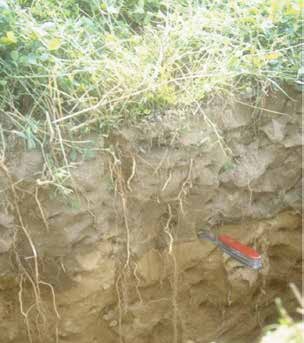chAPter 15 Preventing and lessening CoMPaCtion
high transpiration rates
low evaporation
dry surface layer
prevents
moisture
losses from
deeper layers
soil dries at
greater depths
because of
water uptake by
depth of tillage
roots
Figure 15.8. Cover crops enhance the drying of a clay soil. Without cover crops (left), evaporation losses are low after the surface dries. With cover crops (right), water is removed from deeper in the soil, because of root uptake and transpiration from plant leaves, resulting in better tillage and traffic conditions.
soil surface dries out, it becomes a barrier that greatly
Perennial crops commonly have active root growth early
reduces further evaporation losses. This is often referred
in the growing season and can reach into the compacted
to as self-mulching. This barrier keeps the soil below in
layers when they are still wet and relatively soft. Grasses
a plastic state, preventing it from being worked or traf-
generally have shallow, dense, fibrous root systems that
ficked without causing excessive smearing and compac-
have a very beneficial effect, alleviating compaction in
tion damage. For this reason, farmers often fall-till clay
the surface layer, but these shallow-rooting crops don’t
soils. A better approach, however, might be to use cover
help ameliorate subsoil compaction. Crops with deep
crops to dry the soil in the spring. When a crop like win-
taproots, such as alfalfa, have fewer roots at the surface,
ter rye grows rapidly in the spring, the roots effectively
but the taproots can penetrate into a compacted subsoil.
pump water from layers below the soil surface and allow
As described and shown in chapter 10, forage radish
the soil to transition from the plastic to the friable state
roots can penetrate deeply and form vertical “drill”
(figure 15.8). Because these soils have high moisture-
holes in the soil (see figure 10.4, p. 108). In many cases,
holding capacity, there is normally little concern about
a combination of cover crops with shallow and deep
cover crops depleting water for the following crop.
rooting systems is preferred (figure 15.9). Ideally, such
Cover and rotation crops. Cover and rotation
crops are part of the rotational cropping system, which
crops can significantly reduce soil compaction. The
is typically used on ruminant livestock farms.
choice of crop should be defined by the climate, cropping
The relative benefits of incorporating or mulching
system, nutrient needs, and the type of soil compaction.
a cover or rotation crop are site specific. Incorporation
168
Building SoilS for Better CropS: SuStainaBle Soil ManageMent





